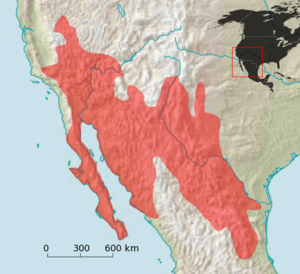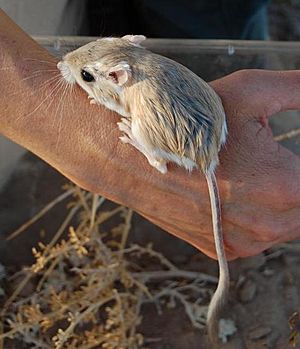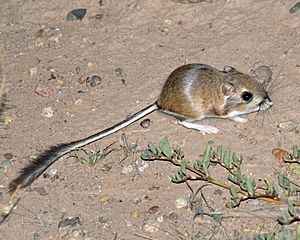Merriam's kangaroo rat facts for kids
Quick facts for kids Merriam's kangaroo rat |
|
|---|---|
 |
|
| Conservation status | |
| Scientific classification | |
| Genus: |
Dipodomys
|
| Species: |
merriami
|
| Subspecies | |
|
Dipodomys merriami ambiguus |
|
 |
|
The Merriam's kangaroo rat (Dipodomys merriami) is a small rodent that lives in the desert. It belongs to a group of animals called Heteromyidae, which includes other kangaroo rats and pocket mice. This species was named after Clinton Hart Merriam, a famous scientist.
Contents
Where Merriam's Kangaroo Rats Live
Merriam's kangaroo rats are found in the dry, warm areas of the southwestern United States, Baja California, and northern Mexico. They prefer places with desert plants and shrubs.
What Merriam's Kangaroo Rats Look Like
Merriam's kangaroo rats are special because they have fur-lined pouches in their cheeks. They use these pouches to carry food back to their homes. They are called "kangaroo rats" because their back legs are very long, like a kangaroo's. They mostly hop or jump instead of running on all fours. To help them balance when they hop, they have a long tail with a big tuft of hair at the end. This tail tuft helps them stay steady, like the feathers on an arrow.
These kangaroo rats are smaller than many other kangaroo rats in the southwest. An adult is usually about 14 inches long. Their fur is light brown or tan, but the exact color can change depending on where they live. They have four toes on each back foot. Other kangaroo rat species, like the Dulzura kangaroo rat and Stephens' kangaroo rat, have five toes.
Home and Habitat
You can find Merriam's kangaroo rats in different desert areas. These include desert scrub, sagebrush steppe, and areas with Joshua trees. They live in burrows, which are tunnels they dig underground.
Behavior and Daily Life
Merriam's kangaroo rats live alone in their burrows, which are like a maze of tunnels. Both males and females have their own areas, called territories. They protect these territories from other kangaroo rats to make sure they have enough food. They often have several entrances to their burrows, usually hidden under shrubs. This helps them escape quickly if a predator comes near.
Most kangaroo rats are active at night. However, they try to stay inside their burrows when the moon is full and bright. The more moonlight there is, the less time they spend outside. They do this to avoid predators who can see them better in the light. During the day, they stay in their cool burrows. They often block the entrances with soil to keep the heat out.
When they are active at night, they gather seeds and plant material in their cheek pouches. Once their pouches are full, they go back to their burrows. Inside, they empty their pouches. Some food is eaten right away, but most of it is stored in special rooms within their burrow system. They can build up a very large collection of seeds!
Kangaroo rats have a clever way to save water. They lose water when they breathe. Since they spend a lot of time in their burrows, the air inside becomes humid. When they store seeds in their burrows, the seeds absorb this moisture from the air. Later, when the kangaroo rat eats the seeds, they get that water back. This helps them survive in the desert without needing to drink much water.
Reproduction and Life Cycle
Merriam's kangaroo rats can have up to three groups of babies, called litters, each year. On average, there are four pups in each litter. The young pups are ready to leave their mother and live on their own about 24 to 33 days after they are born.
What Merriam's Kangaroo Rats Eat
Merriam's kangaroo rats mainly eat plant seeds. They are granivorous, which means their diet is almost entirely made up of seeds from desert and grassland plants. They rarely drink water. Instead, they get most of their water from the food they eat and from a process in their bodies called metabolism.
Predators of Merriam's Kangaroo Rats
Many other desert animals hunt kangaroo rats. Common predators include barn owls, great horned owls, coyotes, foxes, badgers, bobcats, and several types of snakes like sidewinders and glossy snakes. Larger predators like cougars and American black bears might also eat them if they find them, but these animals usually prefer bigger prey.
Conservation Status
For the most part, humans have not harmed Merriam's kangaroo rats across most of their natural range. However, one specific type, the San Bernardino kangaroo rat (Dipodomys merriami parvus), is in danger. This is mainly because of new buildings and homes, as well as changes to rivers and water flow in its habitat in southern California. This subspecies used to be common in the San Bernardino and Riverside areas. In 1998, the United States Fish and Wildlife Service officially listed the San Bernardino kangaroo rat as an endangered species.




